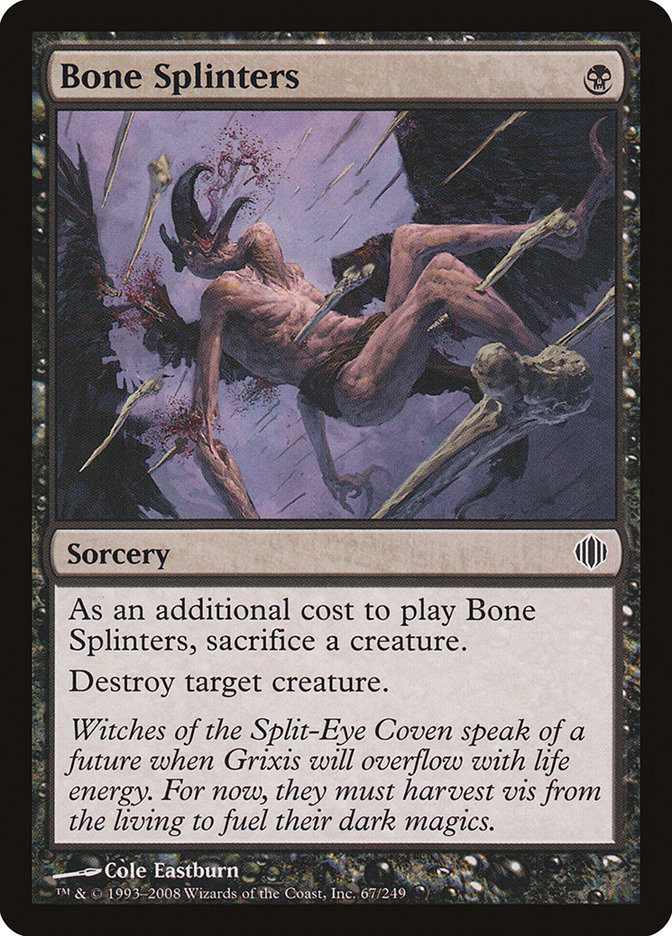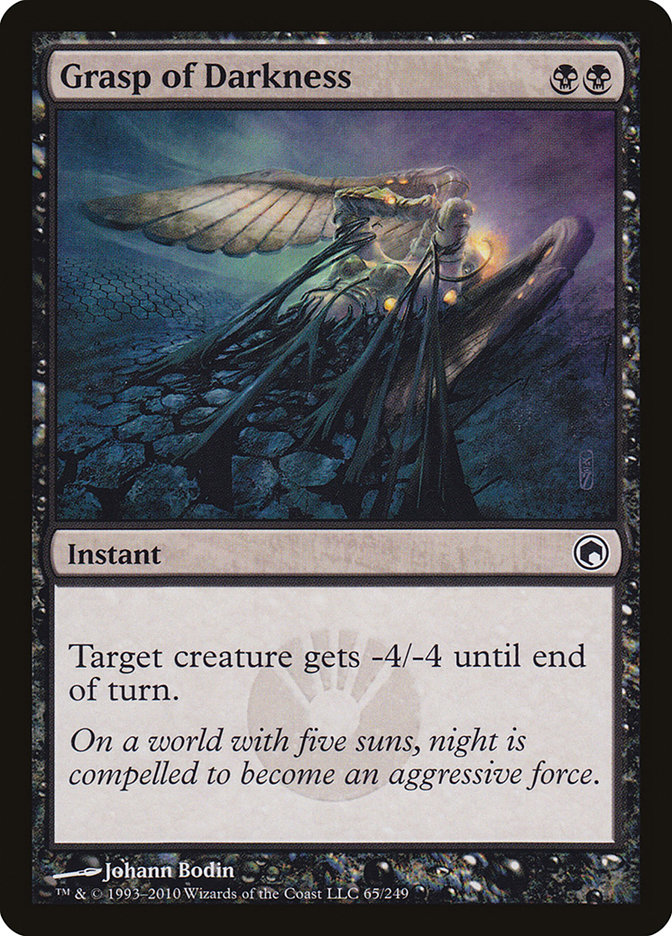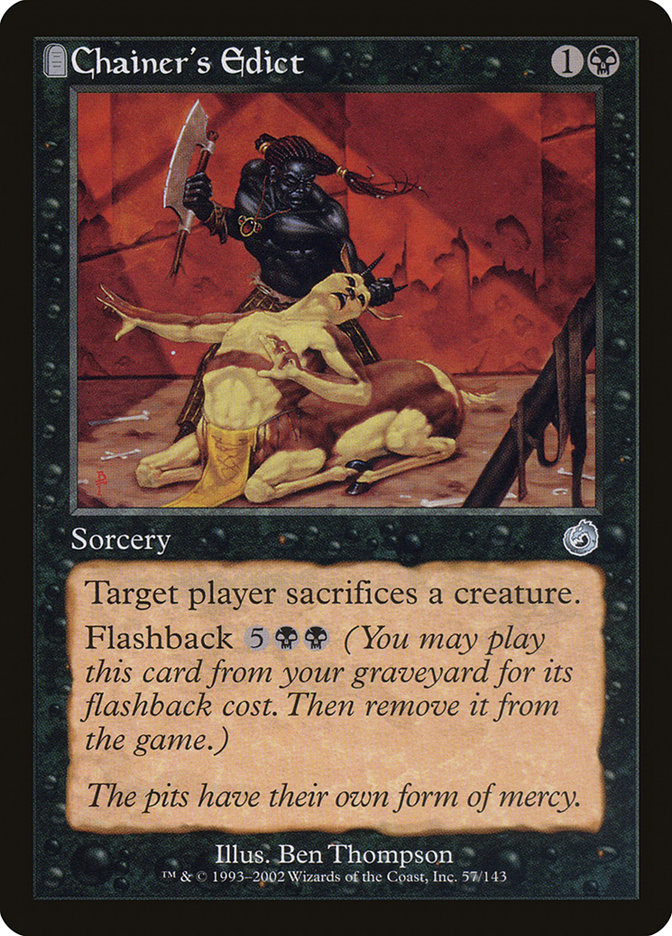Mutual Destruction MTG Card
| Mana cost | |
| Converted mana cost | 1 |
| Rarity | Common |
| Type | Sorcery |
| Released | 2020-04-24 |
| Set symbol | |
| Set name | Ikoria: Lair of Behemoths |
| Set code | IKO |
| Number | 96 |
| Frame | 2015 |
| Layout | Normal |
| Border | Black |
| Illustred by | PINDURSKI |
Text of card
This spell has flash as long as you control a permanent with flash. As an additional cost to cast this spell, sacrifice a creature. Destroy target creature.
Hunter and hunted both died thinking they had outwitted the other.
Cards like Mutual Destruction
Mutual Destruction offers a unique twist to the array of targeted removal spells in Magic: The Gathering. It shares some similarities with cards like Bone Splinters, which also necessitates the sacrifice of a creature for destruction of an opponent’s creature. While Bone Splinters demands an upfront creature sacrifice, Mutual Destruction allows for a tactical advantage by utilizing it as an additional cost during your main phase, potentially creating unexpected plays.
Grasp of Darkness is yet another kindred spell, delivering removal power at the cost of reducing a creature’s strength significantly. While it doesn’t require sacrificing a creature as Mutual Destruction does, it is constrained by only being effective against creatures with lower toughness. Another peer, Chainer’s Edict, forces the opponent to sacrifice a creature. What sets it apart from Mutual Destruction is the potential to be utilized twice thanks to its flashback ability, although typically at a higher casting cost.
In considering the trade-offs among various creature removal spells in Magic: The Gathering, Mutual Destruction stands out for its potential for strategic plays and the surprise factor it can bring to the battlefield due to its additional cost.
Card Pros
Card Advantage: Mutual Destruction grants you the ability to trade one of your creatures for an opponent’s, potentially removing a high-value threat from the board while sacrificing a lower-value asset of your own.
Resource Acceleration: In decks that utilize sacrifice mechanics for benefit, Mutual Destruction can act as an enabler, turning your own creatures into resources. This can effectively accelerate your game plan when paired with cards that thrive on creatures dying.
Instant Speed: The instant nature of Mutual Destruction provides versatility, allowing you to wait for the perfect moment to disrupt your opponent’s strategy during their turn or in response to an action, ensuring you’re always maximizing your tactical advantage.
Card Cons
Discard Requirement: Mutual Destruction necessitates you to discard another card to play it. This can be particularly taxing when your hand is running low on cards, potentially causing you to sacrifice valuable momentum or strategic options.
Specific Mana Cost: This card has a precise mana requirement which could restrict its inclusion to decks where that color is plentiful. Players using a multicolored or colorless deck may find it challenging to meet the mana requirements consistently.
Comparatively High Mana Cost: Mutual Destruction might demand a higher mana investment compared to other removal options available in the MTG card pool. Given that it costs more mana than some alternative cards that achieve similar effects, players could consider it less efficient in certain deck builds.
Reasons to Include in Your Collection
Versatility: Mutual Destruction offers a flexible removal option as it can be easily slotted into decks that are built around sacrificing creatures, further leveraging those synergy strategies.
Combo Potential: This card can trigger death-related abilities and work within a combo that profits from destroying both your own creatures and your opponent’s, offering a dual advantage on the battlefield.
Meta-Relevance: In a game where creature-based strategies are prevalent, Mutual Destruction serves as an efficient tool to manage the board and maintain parity, especially when used in conjunction with cards that benefit from being sacrificed.
How to beat
Mutual Destruction is known for its ability to influence the battlefield by allowing players to sacrifice a creature in order to destroy an opponent’s. With such a removal card in Magic: The Gathering, it’s essential to have strategies in place to counteract its potential impact. Such a card requires a careful analysis of board state and timing; being an instant, it can be played whenever it would be most detrimental to your strategy.
To counter Mutual Destruction, you might consider including cards that can give your creatures indestructible or regenerate abilities, making them immune to destruction effects. It also pays to have a variety of creatures with hexproof or shroud on the board to prevent them from becoming targets. Diversifying your threats so that you’re not overly reliant on a single creature is another effective tactic. Additionally, keeping up counter-magic to negate Mutual Destruction or proactive hand disruption to remove it from your opponent’s hand before it can be a threat can turn the tables in your favor.
Ultimately, being aware that this card can appear in your opponent’s deck means actively preparing for and creating a game plan that includes preventive measures. This can define the difference between a devastating loss and a cunning victory in this intricate dance of strategy inherent to Magic: The Gathering.
Where to buy
If you're looking to purchase Mutual Destruction MTG card by a specific set like Ikoria: Lair of Behemoths, there are several reliable options to consider. One of the primary sources is your local game store, where you can often find booster packs, individual cards, and preconstructed decks from current and some past sets. They often offer the added benefit of a community where you can trade with other players.
For a broader inventory, particularly of older sets, online marketplaces like TCGPlayer, Card Kingdom and Card Market offer extensive selections and allow you to search for cards from specific sets. Larger e-commerce platforms like eBay and Amazon also have listings from various sellers, which can be a good place to look for sealed product and rare finds.
Additionally, Magic’s official site often has a store locator and retailer lists for finding Wizards of the Coast licensed products. Remember to check for authenticity and the condition of the cards when purchasing, especially from individual sellers on larger marketplaces.
Below is a list of some store websites where you can buy the Mutual Destruction and other MTG cards:
 BUY NOW
BUY NOW BurnMana is an official partner of TCGPlayer
- eBay
- Card Kingdom
- Card Market
- Star City Games
- CoolStuffInc
- MTG Mint Card
- Hareruya
- Troll and Toad
- ABU Games
- Card Hoarder Magic Online
- MTGO Traders Magic Online
See MTG Products
Legalities
Magic the Gathering formats where Mutual Destruction has restrictions
| Format | Legality |
|---|---|
| Historicbrawl | Legal |
| Historic | Legal |
| Legacy | Legal |
| Paupercommander | Legal |
| Oathbreaker | Legal |
| Gladiator | Legal |
| Pioneer | Legal |
| Commander | Legal |
| Modern | Legal |
| Pauper | Legal |
| Vintage | Legal |
| Duel | Legal |
| Explorer | Legal |
| Penny | Legal |
| Timeless | Legal |
Rules and information
The reference guide for Magic: The Gathering Mutual Destruction card rulings provides official rulings, any errata issued, as well as a record of all the functional modifications that have occurred.
| Date | Text |
|---|---|
| 2020-04-17 | Once you announce that you’re casting Mutual Destruction, players can’t try to remove your permanents with flash to make it lose flash until you’re done casting it. If it loses flash after it’s been cast, it will still resolve if able. |
| 2020-04-17 | The last time that the game checks whether you have permission to cast a spell is before costs are paid. If you sacrifice a creature with flash to cast Mutual Destruction and then have no other permanents with flash, you’ll legally finish casting Mutual Destruction even though it no longer has flash. In this case, abilities that trigger whenever you cast a spell with flash won’t trigger. |
| 2020-04-17 | You must sacrifice exactly one creature to cast this spell; you cannot cast it without sacrificing a creature, and you cannot sacrifice additional creatures. |

Guide to Flash card ability
Explore the dynamic Flash ability in Magic: The Gathering (MTG), a feature that allows you to cast spells at lightning speed, often leaving your opponents reeling and your strategy several steps ahead. This versatile ability can turn the tide of a game, providing the element of surprise and tactical advantage. It places a premium on timing and foresight, transforming an ordinary deck into a formidable arsenal of instant threats and responses.



